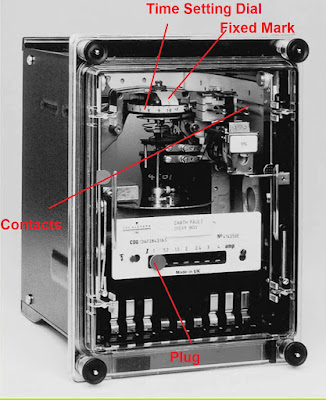Pick-up Current, Plug Setting Multiplier (PSM) and Time Setting Multiplier (TSM)
Plug Setting Multiplier and Time Setting Multiplier are used only for Electromechanical Relays. These terms or parameters are not so used in Numerical Relays but they are conceptually used and incorporated in Numerical Relays too but the way of their implementation is quite different than that of Electromechanical Relays. In this post we will focus on the concept and implementation of Plug Setting Multiplier and Time Setting Multiplier for Electromechanical Relays.
As we know that an Electromechanical Relay has a coil which when energized, operates the Relay to have contact changeover. But there shall be some minimum current which when flows through the Relay coil, produces enough magnetic force to pull the lever to make contact change over. Isn�t it? Yes, if you ever get a chance to see electromechanical relay, you will observe that there is a flapper kind of thing which is attached with the lever. The lever in turn is attached with contacts. Thus when a specified current flows through the relay coil, then only it will produce enough magnetic pull to attract the flapper and lever to operate the Relay. A simple picture of relay demonstrating its construction and operation is shown in figure below.
This minimum current in the Relay coil at which Relay starts to operate is called Pick-up Current. If the current through the Relay coil is less than the pick-up value then Relay won�t operate. On contrary, if the current through the Relay coil is more than the Pick-up current, Relay will operate. In industries, we normally perform Relay Pick-up and Drop-off Test to check the healthiness of relays.
Hope your concept of Pick-up current of Relay is clear now. Now we will move on to Current Setting of electromechanical relays.
Current Setting of Electromechanical Relays: Current Setting of relay is nothing but adjusting its pick-up value. Suppose we are using a CT of ratio 1000/1 A and the pick-up current needs to be set at 1.2 A. Then we will simply put the plug provided on relay coil to 120% or 1.2. Thus we can say that
Pick-up current = Plug Position x Rated CT Secondary Current.
The plug or tapping is provided on the Relay Coil so that changing the position of Plug changes the number of turns of the relay coil as shown in figure below.
As shown in figure above, the plug is kept at 5. This means that pick-up current of relay will be 5 times of rated CT Secondary current. Likewise, if we put the plug at 8.75 then pick-up current of relay will be 8.75 times of the rated CT Secondary current.
Plug Setting Multiplier (PSM): Plug Setting Multiplier (PSM) is defined as the ratio of fault current to the pick-up current of the relay. Thus,
PSM = Fault Current / Pick-up Current
= Fault Current / (Plug Position x Rated CT Secondary Current)
Suppose we are using CT of 100/5 A, a fault current of, say 250 A is flowing through the network protected by the relay. Assume that Current Setting or the position of plug is at 5 then
PSM = 250 / (5x5) =10
It shall be noted here that we shall not bother about PSM for instantaneous relay rather we shall consider PSM for relays having characteristics of Inverse Time, Very Inverse Time etc.
For Detail on Relay Characteristics read Over Current Relay and Its Characteristics
Time Setting Multiplier (TSM): Again it is worthwhile to mention that we shall not bother about TSM for instantaneous relay rather we shall consider TSM for relays having characteristics of Inverse Time, Very InverseTime etc.
A Relay is generally provided with control to adjust the time of operation of the Relay. This adjustment is known as Time Setting Multiplier or TSM. Normally a Time Setting Dial is provided which is calibrated from 0 to 1 s in step of 0.05 s. For practical exposure, let us consider a relay as shown in figure below. Please Zoom the image to clearly view every part of the Relay for better understanding.
As can be seen from the figure, there is a Time Setting Dial which is rotated to set the time of operation of the relay. Lets say we want to set the time on Time Setting Dial to 0.5 s, then we need to rotate the dial till 0.5 s on the dial matches with the fixed mark provided. So our TSM is 0.5 here in the case.
How to find the time of operation of Relay?
Well, assume that plug is set at 5 and TSM at 0.5 s. For finding the actual time of operation of relay we need to refer the Graph between the Operating Time and PSM which is generally provided on the Relay cover itself but in our figure it is not given. So we consider a graph between Operating Time and PSM as shown below.
For our case, PSM = 10 (Please see the calculation and case considered above in our discussion of PSM) and TSM = 0.5 s.
From the Graph, the time of operation of Relay for PSM = 10 is 3 s.
Therefore,
Actual Time of Operation of Relay = 3s x TSM
= 3 x0.5 s =1.5 s
Thus we can say that actual time of operation of Relay is equal to the time obtained from the PSM & Operating Time Graph multiplied by TSM.
Hope your concept of Pick-up current, PSM and TSM is clear. I tried to show you by my practical experience. If still you have any doubt feel free to write in comment box. Thank you!
Pick-up Current, Plug Setting Multiplier (PSM) and Time Setting Multiplier (TSM)
 Reviewed by haru
on
November 19, 2016
Rating:
Reviewed by haru
on
November 19, 2016
Rating:
 Reviewed by haru
on
November 19, 2016
Rating:
Reviewed by haru
on
November 19, 2016
Rating:












No comments